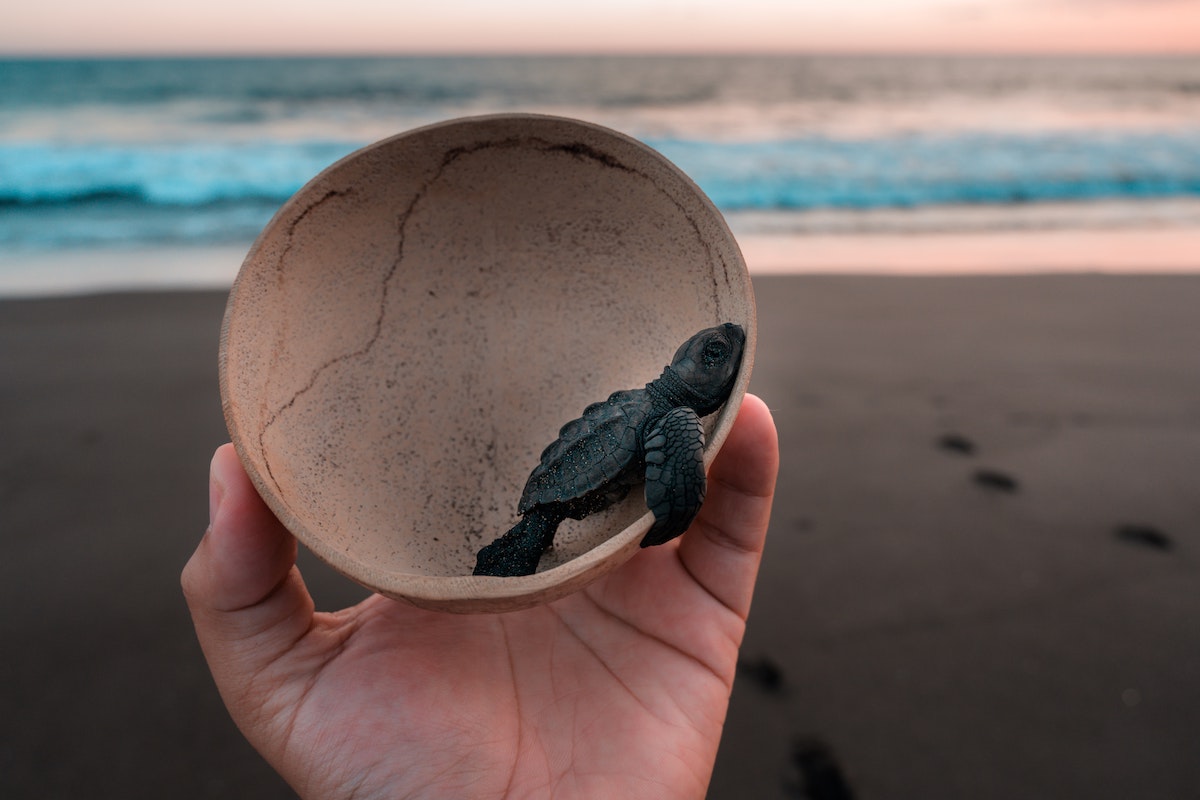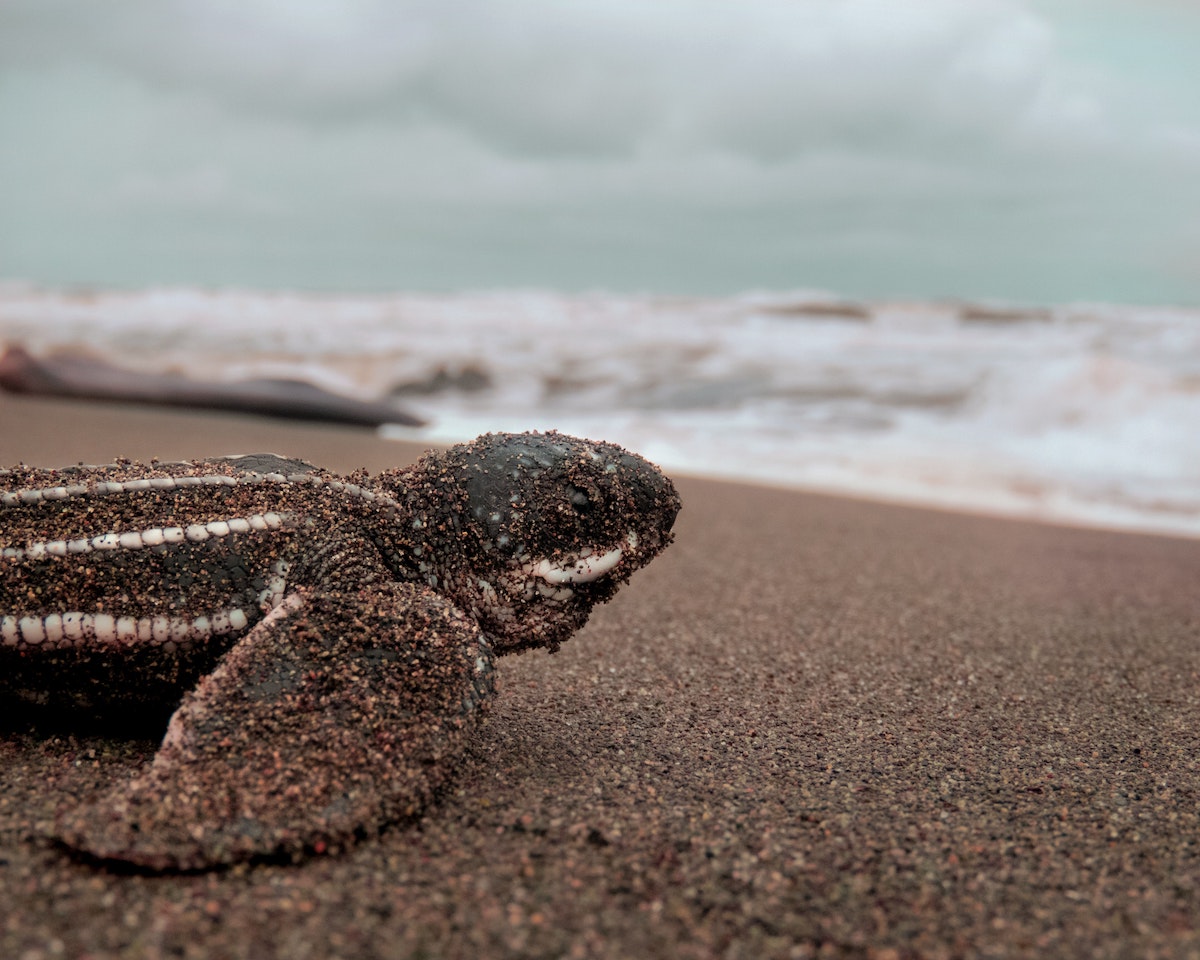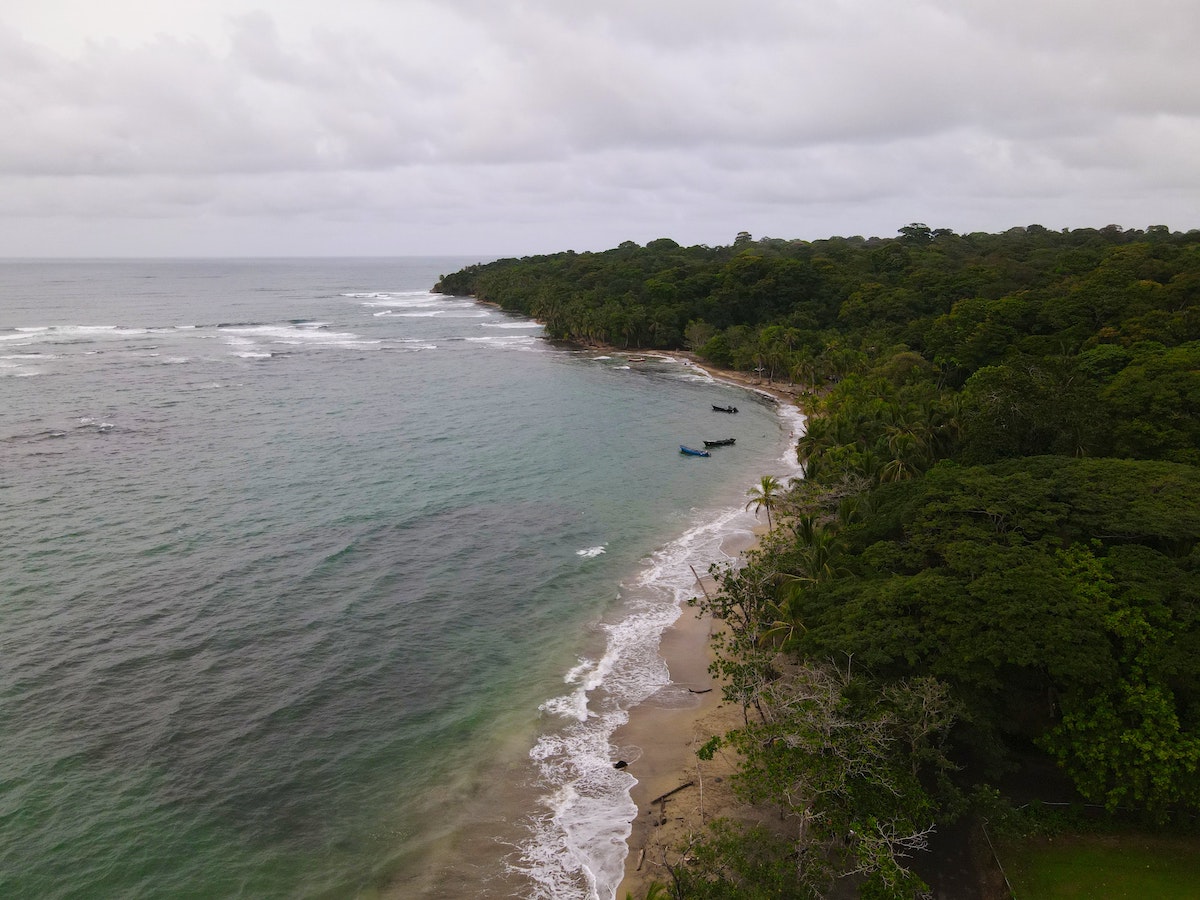
Slapped by a Sea Turtle: Volunteering Abroad in Costa Rica
By: Sarah Stone
Skip to Section
Five of us made our way through the jungle single-file, led by a teenage guide. It was just past midnight, and whether the sky was clear or cloudy, none of us could tell—the thick rainforest canopy blocked all light. Insects chirped, buzzed, and hissed as our small group clumsily pushed past overgrown brush and vines, holding one another’s t-shirts and elbows to stay on track.
Two days before, I’d arrived to San Jose, Costa Rica—my first trip outside of the United States. It was my sophomore year of college, and I’d saved up my internship and side job paychecks to volunteer in Costa Rica that summer. Not only could I start exploring the world, but I could also start actively getting out and doing some good.
A Primer on Leatherback Sea Turtles
That June I would embark on a conservation volunteer project on the Caribbean side of Costa Rica. The program’s goals were to monitor nesting sea turtles, protect their eggs, and release the hatchlings into the ocean. Sea turtles are at risk of extinction due to poachers, pollution, and degradation of their natural environment—the project I’d signed up for worked mainly with leatherbacks, but also monitored green and hawksbill turtles, which occasionally nested in the area.
For months I read about marine biology and conservation, even joining an online group dedicated to turtle research and care (all types—not just sea turtles). I got just a little obsessed.
Among the largest reptiles in the world, the leatherback sea turtle’s carapace grows anywhere from about three-and-a-half feet to nearly six feet long. It has the biggest flippers compared to its body size of any sea turtle, and its back is soft and somewhat leathery and oily—hence the name—rather than bony, like most other turtles.
Leatherbacks can spend more than an hour underwater, reaching depths of 4,200 feet—compared to the deepest known scuba dive of 1,082 feet. They can swim faster than any other turtle at a top speed of 22 miles per hour. Different species of leatherback sea turtles are incredibly widespread, having been found from Norway to Australia.
These turtles cannot be successfully bred or held in captivity—leatherbacks swim almost ceaselessly, with captive ones known to develop cuts, scrapes, and other wounds from treading against the sides of any tank in which they’re kept. No leatherback has been able to thrive upon being released, and as a result, no turtle of this species has been studied in full. There is no definitive answer to how long they can live, or even a comprehensive agreement on their migration patterns.
Despite their widespread distribution, leatherback sea turtles are critically endangered. Their hatchlings—which are comparable in size to other sea turtle hatchlings—immediately seek out and make their way toward the brightest spot they can view after emerging from their eggs. While this light source naturally would be the ocean with sunlight reflecting from it, hatchlings increasingly have been confused, and can head toward houses or, in one unfortunate case, paper lanterns left by a celebrating, newly engaged couple.
During the trip from the nest to the water, hatchlings fall prey to seagulls and other animals, with only a small percentage making it to the ocean. It’s estimated that only one of every 1,000 survive to sexual maturity—as sightings of juvenile leatherbacks are exceedingly rare, researchers still are unsure about what happens during this period between hatching and breeding.
Female leatherbacks nest every two to three years. Atlantic leatherbacks nest between March and July, while Pacific ones return to the beach between September and March. This is the only time they make their way to land, with many turtles returning to their original hatching spot. Most leatherbacks lay about 60 to 90 eggs in a large hole that they dig near the surf with their hind flippers—when finished, they cover the nest back up and move along to the ocean, not returning until they’re ready to lay more eggs.
Knowing facts like these before flying to Costa Rica made me confident I could become a stellar volunteer—and perhaps even a research assistant. If I knew more about the animal we were working with, I thought, I wouldn’t have to scramble to learn the basics while being trained for active conservation work.
An Incredible Community
The tiny community I visited in Gandoca Beach, Costa Rica was comprised entirely of volunteers, research assistants, and local men and women employed by the conservation program—they trained us, housed us, and fed us. A clearing had been made in the jungle where we lived, with a few houses and cabins, a campsite, a bar, and canteen. A quick jaunt down a small rainforest path led us to a beautiful stretch of black sand beach.
The general orientation covered house rules, chores, and schedules. For the next couple of days we learned about our two main projects: beach patrol and hatchery patrol.
For the beach patrol, we would take three-hour shifts each night to hike four miles back and forth along the surf to watch for nesting leatherbacks. If we came across one, we would collect her eggs as she laid them, then transport them to one of the three hatcheries located along the shore. While the turtle was still on land, we would tag her—or check for an existing tag—and note any distinctive markings or scars, measure her carapace, and save this information for research and tracking.
The hatchery patrol volunteers took three-hour shifts 24 hours per day to build protective nests for the transported eggs, guard the nests from poachers, and measure, weigh, and count the baby turtles as they hatched.
On my second night in Gandoca, I was assigned to the midnight beach patrol. I pulled on a pair of black leggings and a long-sleeve gray t-shirt, slipped on a pair of water shoes, and wrapped my flashlight in red cellophane. The other volunteers did the same; the goal was to be as unobtrusive as possible to any leatherbacks we might encounter. By washing off any deodorants, perfumes, or sprays, wearing dark colors, and using a soft red light—only as absolutely needed—we minimized our risk of scaring off a nesting turtle.
Four volunteers and one research assistant gathered at the entrance to the jungle path. Our 16-year-old guide led us through a black maze of creepers, vines, and branches. He moved silently and quickly while the rest of us lumbered along behind him. Under the humid, dark canopy, the jungle is a cacophony of invisible insects—screeches, hoots, and clicks called out on all sides.
As we stepped into the beach clearing, the noises of the jungle died down to give way to crashing waves and a cool breeze from the ocean. Plants and vines closed behind us and we were in the open. The sky was mostly clear, with occasional clouds passing in front of a bright half moon. Our guide headed back to his house while the research assistant led us onward down the beach.
A Slap In The Face

an Olive Ridley sea turtle in the sand – photo by Aaron Katz on Unsplash
Within the first hour, our group came to a stop—a few yards in front of us was a leatherback sea turtle making her way out of the ocean to find a nesting spot. She heaved herself slowly up the sand, making enormous grooves in the surf with her flippers. Each of the volunteers on this patrol had been on the project for at least a month; they knew exactly what to do and moved quickly while I tried to follow along.
I watched her for a moment, almost in shock. While I knew leatherbacks could grow to six feet long, and knew they were the largest turtles in the world, I hadn’t realized just what that meant. She was enormous—her shell was five-and-a-half feet in length, a little longer than I am tall. Her front flippers were half that size, and longer than my arms.
As the turtle found a spot and began to scoop sand away with her powerful hind flippers, our group quickly made our way toward her—the research assistant measured the leatherback’s shell and flippers, and whispered directions while one volunteer put her flashlight between her teeth and jotted notes onto a clipboard.
The turtle had been injured recently; as she tried digging the nest, her right back flipper dug and shifted the sand aside quickly while the left one flapped about helplessly. Concerned that she would head back into the water if we stayed too long, three of us dove in, furiously scooping sand and patting down the sides of what became a nearly three-foot-deep tunnel.
Someone handed me a heavy-duty black garbage bag.
“Can you collect the eggs?”
“Sure!” I squatted over the hole just as the turtle started dropping eggs into it. I grabbed a couple of them, thinking I would collect all the eggs when she was done and plunk them into the bag. As I leaned forward, two of the volunteers hooked their arms around my legs and shoved me face-first into the tunnel. I hadn’t gotten to this part of the training yet.
“Get right in there—that’s it! Now wrap the bag around your elbows. She’ll lay a lot of eggs, so it’ll get heavy in a minute.”
I couldn’t get a grip on the bag quickly enough, frantically wrapping two sides of it around my wrists while the leatherback plopped egg after egg into it. The volunteers pushed me further into the tunnel so that only my hips and legs were sticking out—I was buried up to my waist, upside-down, with my head directly under the turtle’s tail.
While two people steadied me, another walked around the turtle, noting scars, markings, and anything else that could identify her. She’d been tagged by a previous group, so she already nested in that area before. Meanwhile, the leatherback grunted occasionally and continued dropping soft eggs the size of billiard balls into the bag. I had just enough time to wonder whether I’d read anything about this on the turtle forum I frequented prior to my trip.
Within a few moments she slowed down, the eggs becoming smaller in size—some about as big as a golf ball—and less frequent. The bag was incredibly heavy, with more than 75 eggs we later counted.
The turtle grunted one more time and a shot of goo splashed into the nest, drenching the sand, the bag, and me. Don’t know how else to say this: it was disgusting and unexpected. Her flippers slowly began shifting around, trying to bury the nest, and throwing sand and shells on my head and into the bag.
SLAP!
Her powerful right flipper smacked me upside the head.
SPLUT! SMACK! SLAP!
She clearly wanted me out of the way, hitting me repeatedly and grinding sand and egg juice into my nose and hair.
I felt a tug on my legs. Oh thank God.
“Don’t let go of the bag!” someone hissed just as it started to slip from my hands. As two volunteers began pulling me by my ankles, I got a better grip on the garbage bag, trying not to let it drop and crush the eggs at the bottom.
The research assistant wrapped his arms around my waist and the group heaved me up and out of the hole. The leatherback continued methodically filling the hole with wet sand.
We watched for a few moments, and as the turtle finished burying her empty nest and headed back to the water, I thought about the months of research I’d done leading up to this trip. None of it prepared me for this, but it was all right. I’d traveled solo for the first time in my life, I lived in a jungle cabin, and I got slapped in the face by one of the largest reptiles on the planet. What a strangely memorable experience.
About the Author
 As the editor-in-chief of Frayed Passport, my goal is to help you build a lifestyle that lets you travel the world whenever you want and however long you want, and not worry about where your next paycheck will come from. I've been to 20+ countries and five continents, lived for years as a full-time digital nomad, and have worked completely remotely since 2015. If you would like to share your story with our community, or partner with Frayed Passport, get in touch with me using the form on our About page.
As the editor-in-chief of Frayed Passport, my goal is to help you build a lifestyle that lets you travel the world whenever you want and however long you want, and not worry about where your next paycheck will come from. I've been to 20+ countries and five continents, lived for years as a full-time digital nomad, and have worked completely remotely since 2015. If you would like to share your story with our community, or partner with Frayed Passport, get in touch with me using the form on our About page.Featured image via Unsplash.
Information published on this website and across our networks can change over time. Stories and recommendations reflect the subjective opinions of our writers. You should consult multiple sources to ensure you have the most current, safe, and correct details for your own research and plans.
Frayed Passport is a participant in the Amazon Associates Program, an affiliate advertising program designed to provide a means for sites to earn advertising fees by advertising and linking to Amazon.com. We also may share links to other affiliates and sponsors in articles across our website.






